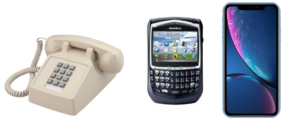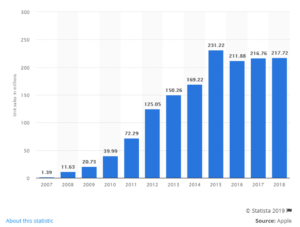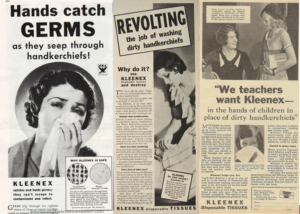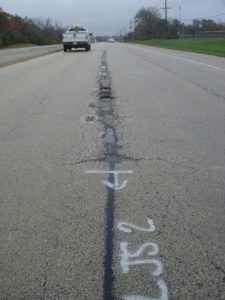A few months ago, we posted an article on the benefits of the Second Mover.
It’s hard to argue that there are strong advantages to being a second mover. There is great opportunity in adopting something new at the point between its introduction and its industry-wide adoption- after it’s been proven, but before the market is saturated.
But there are also benefits to being the first mover, and first movers fill an irreplaceable niche.
From Dials to Touchscreens
Thirty years ago, phones were screenless. You interacted with them using buttons (and before that, a dial!). They lived on desks, bolted to the wall, or on the kitchen counter. They had long, coiled cords that connected the handset to the main body. They could make calls and leave voicemails- and that was about it.
Today, phones are portable computers with more processing power than the entirety of NASA had when they put a man on the moon. We use them to send and receive texts, organize our calendars, respond to emails on the go, play games when we’re in the waiting room, take pictures, engage on social media, and sometimes- even to make phone calls. And gone are the hardware keys and keyboards that defined phones of the past- almost all smartphones manufactured today use touch screens instead. We’ve come an awfully long way since Alexander Graham Bell.
This radical shift was fueled in part by the forward design thinking of one company: Apple. When the iPhone was first launched in 2007, there were other smartphones on the market. But they were still using QWERTY keyboards and styluses- hardware that had been adapted from the previous generation of cell phones.
Apple redefined the smartphone by creating an elegant and straightforward way to interact with your phone. They did something that no one else in the industry had done yet: they eliminated the hardware keyboard and made the phone completely reliant on a touchscreen. Their forward-thinking approach to user interactivity helped launch the iPhone into astronomical commercial success, peaking at 231 million units sold in 2015. As of this quarter, Apple phones make up over 40% of the American smartphone market share.Their stock value more than doubled in the year the iPhone was released and has continued to grow in the years since.
Unit sales of the Apple iPhone worldwide from 2007 to 2018 (in millions) – Source: Statista
In addition to achieving incredible profitability and brand recognition, Apple changed the very definition of “smartphone.” Almost every smartphone to premiere since the iPhone has adopted similar design; while smartphones with hardware keyboards still exist, they are an extreme minority in the market. That’s the power of the first mover.
Creating a New Market
Prior to the invention of disposable facial tissues, the handkerchief was the tool of choice when it came to blowing one’s nose. Kleenex was originally invented to help remove cold cream. They were used exclusively by ladies as part of their nightly beauty routine- until Kleenex received letters of complaint from their customers saying that their husbands kept using Kleenex to blow their noses. Instead of discouraging this behavior, Kleenex leaned into it! Kleenex ran a series of ads denigrating handkerchiefs- claiming that they harbored disease, were inconvenient, and that washing them was a “revolting” chore. Clearly, a single-use, disposable alternative was the sanitary answer!
Today, handkerchiefs are a thing of the past. Just about every American school and workplace is equipped with Kleenex. By seizing an opportunity to be the first, Kleenex has become so universally popular that it’s brand name is a synonym for the generic product– people refer to any facial tissue as “Kleenex” regardless of the brand. They continue to be a dominant brand in the facial tissue market. Their early entry into this market gave them a significant edge that continues to benefit them to this day.
Rethinking Roads
A little over 100 years ago, most roads in the United States consisted of gravel or dirt. With the emergence of automobiles in the 1910s, there was increasing pressure on the government to create a more sophisticated highway system for travel. In just a few decades, America went from having a haphazard network of interconnected local roads to a fully-developed interstate system. Today that interstate system connects the entire country and consists of 46,876 miles.
The pursuit of the perfect road continues to this day. Improved mix design, new paving techniques, and superior products have made modern roads tougher and longer-lasting than their predecessors. But problems persist, and the stakeholders in infrastructure- agencies and businesses alike- have to keep rising to the challenge of overcoming them.
One such stakeholder is the Illinois Department of Transportation. Facing the same difficulties as every DOT across the country- a budget that feels smaller every year, roads that get worse every year, and increasing public frustration- IDOT decided to tackle the number one problem in asphalt paving: longitudinal joint failure.
Because the pavement at the joint has lower density, it’s more permeable to air and water. This makes it the most vulnerable part of the pavement. It’s always the first to fail, and the catalyst for other forms of damage.
It’s also the most expensive part of any pavement. It has rumble strips, pavement markers, and striping, which add to the cost of constructing and maintaining this portion of the pavement. It needs extra attention during construction in order to make the density at the joint closer to the density in the middle of the paving lane.
Rather than approaching the problem of density from a mechanical angle- e.g. developing new compaction protocols- IDOT decided they wanted to try and solve joint failure with a materials approach. They sent this challenge out to the asphalt industry and the Heritage Research Group answered.
HRG’s solution was a void-reducing asphalt membrane (VRAM) that would go on to be known as J-Band. This hot-applied asphalt product would be applied underneath the joint before it was paved, then melt upwards into the joint to fill air voids in order to reduce the permeability at the edge of paving.
Other companies also answered the call for IDOT’s experiment. In 2002, IDOT paved test projects in locations around the state of Illinois to see how J-Band and the other submitted materials would perform. One such project was paved on US 51 in Macon County. This is what IDOT saw on the J-Band sections of this test project when they reviewed it in 2017:
The top portion was a control section, and the bottom shows where J-Band was applied.
IDOT was impressed with J-Band’s performance and began using it on projects in 2016. Today all new IDOT projects must include a void reducing asphalt membrane (VRAM) like J-Band. A typical longitudinal joint will start needing attention after just four or five years. The test section in Macon County has lasted 17 with J-Band. IDOT expects to see substantial cost savings on maintaining their infrastructure by implementing this technology.
First Movers Move the World
Without people who are willing to think outside the box, attack an obstacle from a new angle, and make the first move, the world would be a stagnant place. Every industry relies on innovation for progress. Without it, we’d still be using rotary phones, hankies, and gravel roads.
From a business angle, the financial benefits of being the first mover can be immense. Like Kleenex or Apple, being the first mover creates an opportunity to launch or revolutionize an industry- and make a significant return on investment for doing so.
A Powerful Opportunity
Since its adoption by IDOT in the 2016, J-Band has been used by twelve states and dozens of agencies. Pictures like the one above and IDOT’s positive experience with J-Band have given other states the confidence to begin using J-Band on their own projects- without having to spend over a decade evaluating it, like Illinois did.
J-Band is at a unique point in its history where adopters of this technology can benefit from both the first mover advantage and the second mover advantage. With 17 years and counting of field performance, J-Band has proven effective beyond the shadow of a doubt. Adopters are not taking a risk with their budget or their roads by implementing J-Band. But there is still some opportunity for early adopters to enter regions where J-Band is not yet being used- and to become the first mover in the context of their own individual market. J-Band carries the low-risk benefits of a second mover item with many of the first mover advantages of a brand-new technology.





